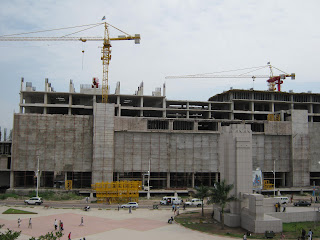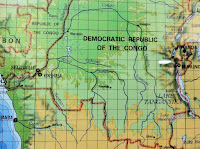As some of you know, Elder Smith and I got locked out of our apartment on our first Saturday because he wanted me to go out onto the wrap-around roof to see some sights. Unfortunately, he closed the sliding doors a little more forcefully than usual & it tripped the lock, which we discovered when we tried to get back in about an hour later. We were keyless and phoneless (but I DID have my camera) and were only rescued from the roof when I saw a UN worker arriving home and called down to her. Luckily, she called a co-worker who just happened to live next door to our upstairs mission couple, the Staggs. The had access to a locked entry to the roof and came and got us after we'd been stranded three hours. The good news is that it was an unusually mild day with a gentle breeze and I got to take a LOT of pictures.
First of all, this is NOT our apartment building. It is a very lovely structure right across the street from us. We are on the 3rd floor of a tall apartment building owned by the US Embassy. It houses mostly U.N. and USAID employees. We have never seen the man who lives across the hall from us because he is fighting in "the east", as they say here... part of the small contingent of US military trying to root out a cruel and vicious rebel leader.
This, on the other hand is a view of the building right next to the pretty one above. Did you think it was being constructed? Au contraire! It, like many buildings in Kinshasa, is being "de-constructed". The city is full of huge construction projects which were discontinued due to lack of funds and left abandoned. In this case, they are actually tearing it down.
This is a large Catholic school on the southeast side of our apartment. Since it was Saturday, the children weren't there, but I've seen them during the week... the boys dressed in dark pants with a white shirt & tie and the girls in the traditional plaid jumper & white blouse. They are neat & clean and are quite cute.
The fountain is part of a plaza which we overlook from our northwest side. It marks the beginning of The Boulevard Du 30 Juin, the eight lane road which is the pride of Kinshasa and celebrates the 30 June 1960 independence from Belgium. We take this route every morning to the Mission Office about 1 1/2 miles away. Before we got here, I thought it would be an incredibly close & easy ride. Now, I realize that having several "near-death" experiences every morning & every afternoon makes for a very long commute.
The Congo River bends around us, so it's just beyond the taller buildings in this picture, but much closer on the other side of our building.
I zoomed in on the little Congolese family just to get a picture of the oft-seen way the people carry things. I can assure you that I've seen hundreds with far bigger & heavier loads when I was in the car and couldn't get my camera set quick enough.
This is an example of what you see a hundred times a day. All of the "transportation" buses, cars, taxis (whatever else might be called a vehicle) are very old and badly beat up... no surprise when you see how they drive in the Congo. The drivers use two methods of communication... a horn, preferably leaned on about every five seconds, and a man (volunteer?) who leans out of the vehicle making various hand signals (which we haven't been able to interpret). As soon as possible, I am going to learn how to use Elder Smith's pocket cam and capture the experience of Kinshasa traffic, though I'm told that even video doesn't do it justice. After all, the viewer is looking at it in the safety of his comfortable home and does not have to worry about his proximity to death or injury.
The U.N. has a huge presence here, but the general opinion is that they have not contributed much to the betterment of the country. To the right, you see another common sight... a "pus-pus", which is used for every conceivable type, size & weight load. This in turn might also have a person or two sitting atop.
I loved the elegant look of this Congolese woman walking across the plaza.
Security is big business in Kinshasa. Every government building and most large company/apartment buildings have concrete walls & steel doors to be opened.You see uniforms everywhere and have to learn which ones are actually police. Those are the guys to be avoided. They get very little (if any) pay, but rely on stopping people and getting a bribe. Congolese citizens MUST stop. We are advised NOT to stop (and ALWAYS have our car doors locked). But if we are blocked, we are to keep the window within an inch of the top, smile & show our papers through the window, politely refuse to pay a fine & NEVER pull over, even if angrily commanded to do so by an armed man.
This is another example of the "pus-pus" (probably from the French for "push").
I wish you could see how many people cram into these transportation vehicles. Often, the person in the very back almost falls out when the door is opened.
Can you imagine any Congolese woman having bad posture after a life time of walking like this?
Sometimes they "cheat" a little by reaching up to steady the load, but rarely.
It's so much cheaper to have an open truck, but there always has to be one or even two men in the back so that, when the truck slows or stops, no one grabs a crate & runs away with it.
This is a large Catholic school on the southeast side of our apartment. Since it was Saturday, the children weren't there, but I've seen them during the week... the boys dressed in dark pants with a white shirt & tie and the girls in the traditional plaid jumper & white blouse. They are neat & clean and are quite cute.
The fountain is part of a plaza which we overlook from our northwest side. It marks the beginning of The Boulevard Du 30 Juin, the eight lane road which is the pride of Kinshasa and celebrates the 30 June 1960 independence from Belgium. We take this route every morning to the Mission Office about 1 1/2 miles away. Before we got here, I thought it would be an incredibly close & easy ride. Now, I realize that having several "near-death" experiences every morning & every afternoon makes for a very long commute.
The Congo River bends around us, so it's just beyond the taller buildings in this picture, but much closer on the other side of our building.
I zoomed in on the little Congolese family just to get a picture of the oft-seen way the people carry things. I can assure you that I've seen hundreds with far bigger & heavier loads when I was in the car and couldn't get my camera set quick enough.
This is an example of what you see a hundred times a day. All of the "transportation" buses, cars, taxis (whatever else might be called a vehicle) are very old and badly beat up... no surprise when you see how they drive in the Congo. The drivers use two methods of communication... a horn, preferably leaned on about every five seconds, and a man (volunteer?) who leans out of the vehicle making various hand signals (which we haven't been able to interpret). As soon as possible, I am going to learn how to use Elder Smith's pocket cam and capture the experience of Kinshasa traffic, though I'm told that even video doesn't do it justice. After all, the viewer is looking at it in the safety of his comfortable home and does not have to worry about his proximity to death or injury.
I loved the elegant look of this Congolese woman walking across the plaza.
Security is big business in Kinshasa. Every government building and most large company/apartment buildings have concrete walls & steel doors to be opened.You see uniforms everywhere and have to learn which ones are actually police. Those are the guys to be avoided. They get very little (if any) pay, but rely on stopping people and getting a bribe. Congolese citizens MUST stop. We are advised NOT to stop (and ALWAYS have our car doors locked). But if we are blocked, we are to keep the window within an inch of the top, smile & show our papers through the window, politely refuse to pay a fine & NEVER pull over, even if angrily commanded to do so by an armed man.
I wish you could see how many people cram into these transportation vehicles. Often, the person in the very back almost falls out when the door is opened.
Can you imagine any Congolese woman having bad posture after a life time of walking like this?
Sometimes they "cheat" a little by reaching up to steady the load, but rarely.
It's so much cheaper to have an open truck, but there always has to be one or even two men in the back so that, when the truck slows or stops, no one grabs a crate & runs away with it.









































+010.JPG)